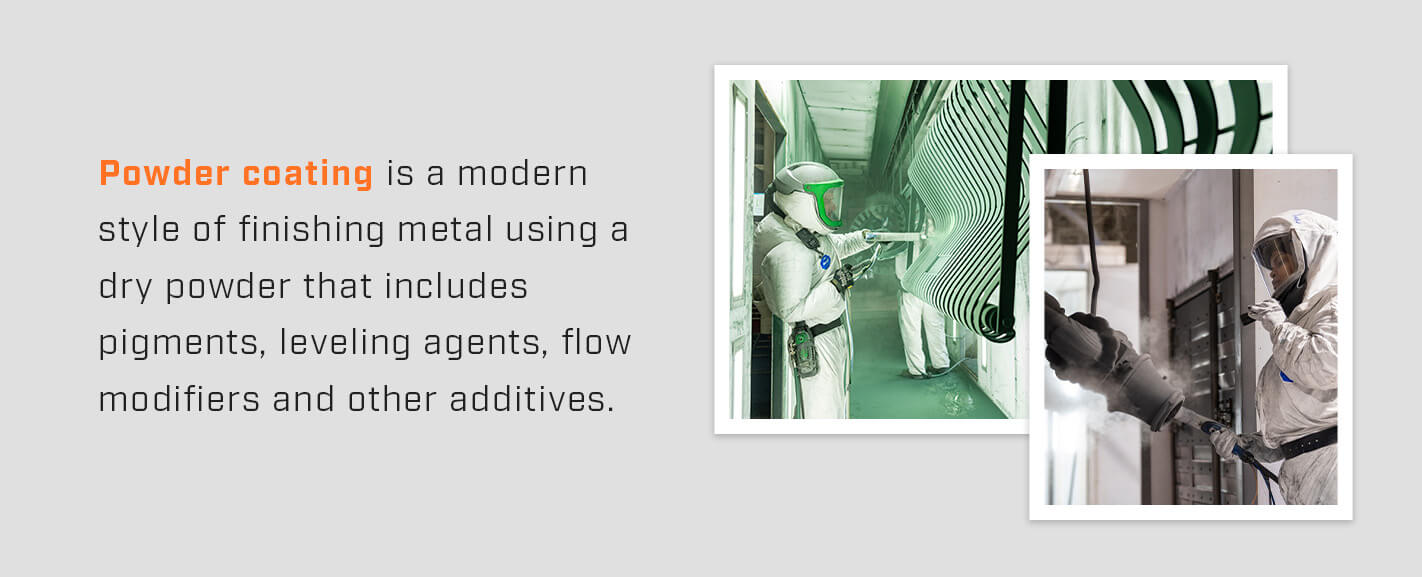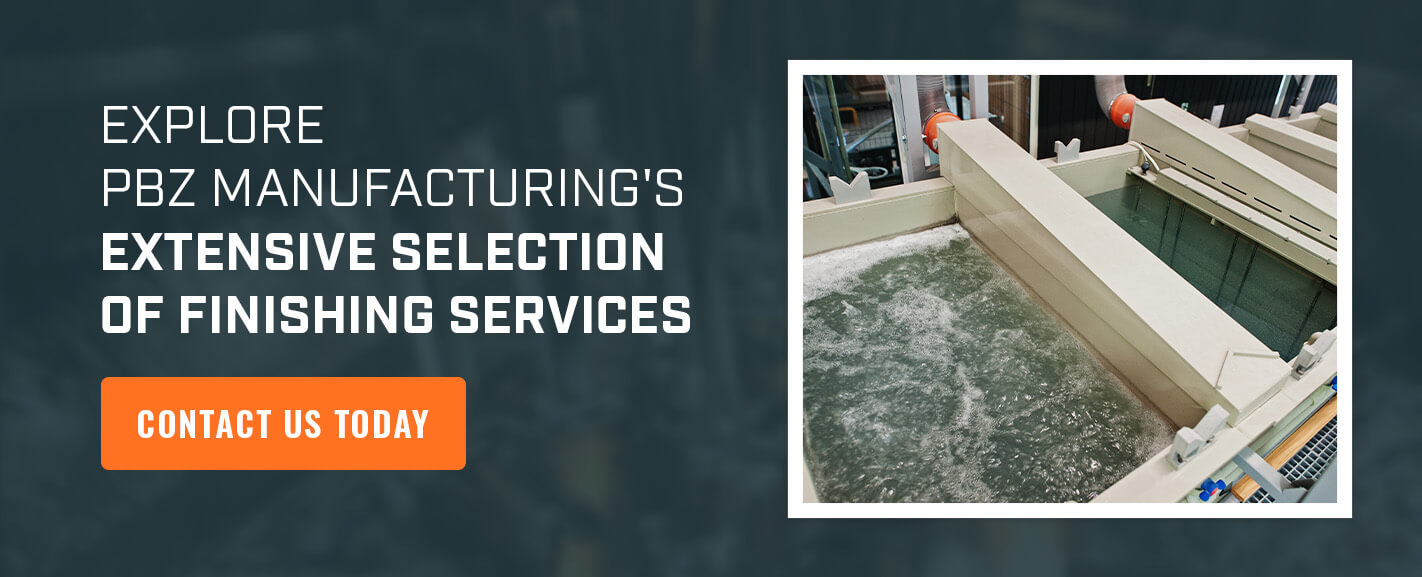
Metal finishing is the process of treating metal surfaces with a thin material or polishing process to alter their exterior. There are many types of metal finishes that produce different effects. Some improve the appearance, durability and conductivity of a metal product or component, while others impart corrosion, chemical and abrasion resistance.
Each type of metal finish offers unique benefits and is suited to different types of metals and applications. They also have varying time, labor and money requirements, which makes it essential for you as a manufacturer to understand how to choose the best one for your specific project and substrate. Below, we get into seven common types of metal finishes and their appropriate applications.
Electroplating is the process of coating a metal substrate with another metal or metal alloy, such as copper, zinc, silver or nickel. Also called electrodeposition, electroplating involves placing a metal part or component in a tank filled with a positively charged electrolyte. An electric current then splits the electrolyte to deposit the ions on the substrate. This process forms a thin metallic layer on the surface of the metal workpiece.
Manufacturers can use a combination of metals to form multiple layers on a product and maximize conductivity and strength. Electroplating enhances a metal’s resistance to wear and tear, corrosion, friction and abrasion. It’s often used when finishing automotive parts, coins, jewelry, tin cans, sink taps, pots and pans.

Powder coating is a modern style of finishing metal using a dry powder that includes pigments, leveling agents, flow modifiers and other additives. The process involves spraying the dry powder onto a charged substrate that attracts the particles to form a coating. It’s then cured using UV rays or heat to ensure the coat covers the metal part evenly, forming a matte, glossy or textured finish. A textured powder coat hides defects on a metal surface.
Powder coating is more durable and aesthetically pleasing than paint. It’s also more sustainable and environmentally friendly because the unadhered powder can be gathered and reused. Additionally, it does not require solvents that contribute to air pollution. Powder coating can withstand harsh environmental conditions because it’s resistant to alkaline substances, fading and chipping.
A powder-coated finish is suitable for various automotive, agricultural and electrical applications. These include coating metal parts for:
Also known as chemical or autocatalytic plating, electroless plating is a metal finishing technique that involves coating metal substrates with metal ions via a chemical process rather than using electricity. This method involves dipping a metal component into a reducing chemical bath that’s catalyzed to deposit metals like copper, nickel, silver and gold to the part’s surface.
It requires no electric current to produce a coating of varying thickness and volume. Electroless plating can achieve matte, glossy or semi-glossy finishes that are hard, nonporous and resistant to corrosion. Some coatings can also reduce friction, which makes them ideal for components such as food and injection molds, brake pistons, pipe fittings, dies and pump housings. Electroless plating has multiple uses in the automotive, aerospace, oil and gas industries.
Commonly called e-coating, electrocoating is a metal finishing process that follows the same principles as electroplating. It involves immersing a metal substrate in an epoxy or water-based paint solution and using an electric current to deposit the suspended particles on the material’s surface. Technicians determine the thickness of the coating, and when satisfied, they rinse the substrate and cure it in an oven.
Electrocoating is best used for workpieces with many hard-to-reach interior surfaces requiring ultra-thin finishes. Generally, an e-coat is used as a primer for parts requiring high corrosion resistance, after which the manufacturer applies a more protective and UV-resistant finish, such as powder coating. The appliance and automotive industries are the most prevalent users of e-coating.
The galvanizing process involves submerging metals in molten zinc to form a thick protective layer. It relies on the chemical reactions between zinc, carbon dioxide and oxygen at high temperatures to form a durable silver zinc carbonate film. Galvanizing is an effective process for coating every edge of a material, especially after manufacturing. However, it limits your aesthetic options because it’s only available in one color.
Galvanizing metal yields a durable, high-quality protective layer that resists corrosion and rust. This characteristic makes it ideal for manufacturing long-lasting equipment for use in residential and commercial properties, agriculture, oil and gas, and consumer goods. In sports, it’s a preferred coating process for metal used to make gym equipment.
The anodizing process is an electrochemical procedure that involves oxidizing the outer layer of a metal workpiece by soaking it in chromic acid electrolyte and passing an electric current through it. The result is an attractive, durable and corrosion-resistant finish that increases the metal’s resistance to everyday wear and tear.
This process is often used to finish aluminum, magnesium, titanium and zinc parts used for mechanical and automotive applications. Anodized metal parts serve as many interior and exterior building fixtures, such as handrails and ladders.
Abrasive blasting is a metal finishing process that uses high-pressure air to blow a stream of abrasive material against the surface of a metal substrate. The abrasive materials used during this process may include corn cobs, steel shot, aluminum oxide, sand, plastic grit, silicon carbide, carbon grit or glass beads. These materials will strip away debris, rust and even old finishes, leaving a smooth surface behind. The abrasive media used during blasting will affect the resulting finish — aluminum oxide leaves a matte surface, while glass beads give the workpiece more of a satin look.
Blasting is a low-cost method of cleaning and preparing a surface prior to a plating or coating application. It produces a smooth surface that allows the manufacturer to move seamlessly to the next step of the process. This finishing technique is often used for automotive repair and restoration, warehouse cleaning and bridge maintenance.

PBZ Manufacturing is a metal manufacturer providing a variety of finishing services for many different metal parts and products. As an all-in-one solutions provider, we offer pre-treatment solutions ranging from blast-cleaning and surface preparation to primer and masking application before the finishing. We also perform quality testing, and we’re your go-to provider for assembling and custom-packing finished metal parts and components.
If you’re in the market for metal finishing for your components, request a quote online today. We’ll get back to you within 4 business hours. You can also call us at 717-584-8767 to speak to one of our knowledgeable customer service representatives about your project.